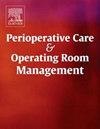选择性剖宫产产妇传统坐姿与盘腿坐姿脊柱麻醉的比较——一项随机对照试验
IF 1
Q2 Nursing
Perioperative Care and Operating Room Management
Pub Date : 2025-09-22
DOI:10.1016/j.pcorm.2025.100556
引用次数: 0
摘要
背景脊髓麻醉是剖腹产的首选技术,因为它对母亲和胎儿都有好处。适当的患者体位至关重要,因为它可以改善患者的舒适度,减少所需的时间和尝试次数,并减少手术过程中针头和骨头接触的次数。我们的研究主要是为了比较坐姿和盘腿坐姿成功放置针头的次数。次要目标包括患者舒适度、触诊便利性和阻滞特征。方法本研究为前瞻性、非盲、单中心研究。使用计算机生成的随机表和不透明包膜技术将患者随机分配到两组中的一组。共有110例择期剖宫产产妇采用传统坐姿或盘腿坐姿进行脊柱麻醉。结果两组产妇年龄、身高、体重具有可比性。两组患者尝试次数相等,60%的患者第一次尝试成功;n = 33, p值= 0.384)。结论两种体位均具有可比性,可根据产妇的舒适度和偏好选择传统坐位进行脊髓麻醉本文章由计算机程序翻译,如有差异,请以英文原文为准。

A comparison of spinal Anaesthesia in traditional sitting position versus cross-legged sitting position in Parturients undergoing elective caesarean section—a Randomised controlled trial
Background
Spinal anaesthesia is the preferred technique for caesarean delivery, owing to the several benefits it carries for mother and fetus. Appropriate patient positioning is vital as it improves the patient comfort, reduces the time taken, the number of attempts required, and decreases the number of needle and bone contacts during the procedure. Our study primarily aimed to compare number of attempts taken for successful needle placement in a sitting position versus a cross-legged sitting position. Secondary objectives included patient comfort, ease of palpation, and block characteristics.
Methods
Our study was a prospective, nonblinded, single-centre study. The patients were randomly assigned to one of the two groups using a computer-generated randomisation table and opaque envelope technique. A total of 110 parturients posted for the elective caesarean delivery received spinal anaesthesia in either a traditional sitting position or a cross-legged sitting position.
Results
The parturients in both groups were comparable in terms of age, height and weight. The number of attempts was equal in both groups, with 60 % of patients were successful at 1st attempt; n = 33 p-Value = 0.384). The landmark palpability, block characteristics and patient comfort were comparable in both groups
Conclusion
We found comparable results in both positions, either traditional sitting position can be used to administer spinal anaesthesia in parturients based on their comfort and preference
求助全文
通过发布文献求助,成功后即可免费获取论文全文。
去求助
来源期刊

Perioperative Care and Operating Room Management
Nursing-Medical and Surgical Nursing
CiteScore
1.30
自引率
0.00%
发文量
52
审稿时长
56 days
期刊介绍:
The objective of this new online journal is to serve as a multidisciplinary, peer-reviewed source of information related to the administrative, economic, operational, safety, and quality aspects of the ambulatory and in-patient operating room and interventional procedural processes. The journal will provide high-quality information and research findings on operational and system-based approaches to ensure safe, coordinated, and high-value periprocedural care. With the current focus on value in health care it is essential that there is a venue for researchers to publish articles on quality improvement process initiatives, process flow modeling, information management, efficient design, cost improvement, use of novel technologies, and management.
 求助内容:
求助内容: 应助结果提醒方式:
应助结果提醒方式:


